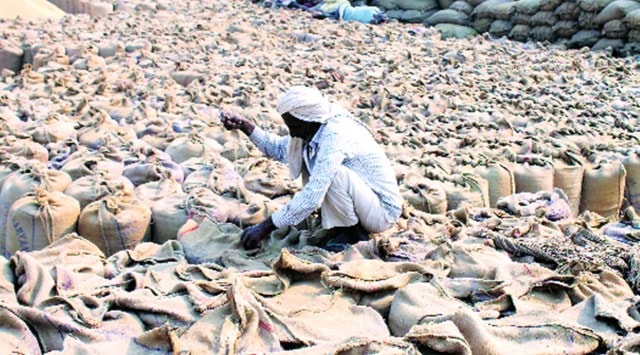- India
- International
Behind arhtiyas joining farmers’ stir: Fear of losing hundreds of crores in annual income
There are around 28,000 active arhtiyas in Punjab out of which 50 per cent are the ‘Baniya Arhtiyas’ (traditional arhtiyas), while the other 50 per cent are ‘Zamindar Jatt Arhtiyas’ (mostly farmers’ themselves).
 One arhtiya on an average has 50 to 200 farmers asssociated with him. (Archive)
One arhtiya on an average has 50 to 200 farmers asssociated with him. (Archive)With passing of the Farmers’ Produce, Trade, and Commerce (Promotion and Facilitation) Act, the arhtiyas (commission agents) of Punjab are set to lose around Rs 1700 to Rs 1800 crore annually in ‘commission’. While the impact of this is already being seen in the sale-purchase of cotton, basmati and non-MSP crops, the new law is also going to hit their income as credit and farm input suppliers, which runs into thousands of crores. This is a major reason that has led them to back the farmers’ protest against agri Acts.
There are around 28,000 active arhtiyas in Punjab out of which 50 per cent are the ‘Baniya Arhtiyas’ (traditional arhtiyas), while the other 50 per cent are ‘Zamindar Jatt Arhtiyas’ (mostly farmers’ themselves).
Most of the Jatt Arhtiyas joined this trade in the post-terrorism period in Punjab. According to an estimate, Malwa region of Punjab has 40 per cent Jat Arytiyas, Majha and Doaba regions have 60 per cent such arhtiyas of the total number of arhtiyas in these respective regions. The entry of zamindars into arhat took place mainly due to the attraction of the 2.5 per cent commission.
In Punjab, according to the government, there are 18.50 lakh farmers who are handled by 28,000 arhtiyas.
On an average, every arhtiya in Punjab can have 65 farmers associated with him, but this number varies from 50 to 200 farmers associated with each arhtiya, who are big, medium and small.

In the mandis, arhtiyas acts as a facilitator between the farmers and the purchasers (both government and private players).
The ‘J form’, which gives details of the crop, quantity, and price, and mentions the names of farmers, is filled by the farmers to handover their crop to arhtiyas for selling purposes. But these middlemen merely maintain “J forms” that disclose nothing about the actual receipt of payment by farmers, who do not get direct payment from the government but through arhtiyas only.
When a farmer brings his produce to a mandi and unloads it at the yard of an arhtiya, who gets grain cleaned and organises its auction, he then arranges for weighing, filling into bags and stitching prior to loading into the trucks of the buyers. For all these services rendered, the arhtiya gets a 2.5 per cent commission per quintal wheat, paddy, basmati, and maize by the purchaser, 2 per cent commission per quintal for cotton, 1.5 per cent commission for chilli.
They sell around 160 lakh tonnes paddy (16 million tonnes) and 125-130 lakh tonnes (12.5 to 13 million tonnes) wheat, 42 to 43 lakh quintals cotton, 5 to 5.50 lakh tonnes maize, 2.5 to 3 million tonnes basmati, and less than half a million tonnes of pulses, oilseeds, barley, guwara, grams, chilli etc.
According to Punjab Food and Civil Supplies Department, the annual commission paid to the arhtiyas is around Rs 1,400 crore on paddy and wheat, which are the major crops of the state and are purchased by the Centre, Rs 150 crore on Basmati, Rs 100 crore on cotton, around Rs 30 crore on maize, Rs 10 crores on oilseeds, pulses, barley, grams etc. and nearly Rs 4 crores on chilli purchase.
For instance in 2019-20, 162.27 lakh tonnes (LT) of paddy and 127.62 LT of wheat got procured from Punjab at their respective MSPs of Rs 1,835 per quintal and Rs 1,925 per quintal, respectively, would have been worth almost Rs 56,000 crore. At 2.5 per cent, the commission payments to the arhatiyas would have totalled around Rs 1,400 crore.
Arhtiyas claimed that out of 2.5 per cent commission nearly 1 to 1.25 per cent is their expenditure on providing weighing machines, tarpaulin, power cleaner, keeping regular staff like ‘munims’ (Accountant) etc.
This is not the only a source of income for them, arhtiyas also make money from providing all the farm inputs like seed, fertilisers, pesticides, cattle feed etc. to the farmers from their own shops or from shops various dealers linked to them and thus earning commission from there too.
Jagmohan Singh, General Secretary, Bharti Kisan Union (BKU) Dakuanda said that, “If farmers are forced to sell in the open market then they may lose contact with arhtiyas, who are controlling them currently and supply such farm inputs”.
An expert of Punjab Agriculture University (PAU) said that the arhtiyas are also making big bucks by providing credit to the farmers at 18 to 24 per cent rate of interest and according to an estimate around 20 per cent (Rs 18,000 to 20,000 crores) of the total debt of the farmers in Punjab is provided by the arhtiyas, who hardly provide any fair record to the farmers about their return and farmers always remained indebted to them.
“Arhtiyas who always object direct payment to the farmers by the government are fearing that after the implementation of this Act farmers may not come to them when they will sell in the open market and thus they will lose hold on them and the earnings from the credit provided to them,” said farmer leader Jagsir Singh, adding that we are against the arhtiya system, but we will not let this Act be implemented.
“Barring wheat and paddy, all other crops in Punjab are purchased by the private players who can now purchase directly from farmers and there is no need of arhtiyas and its impact has started showing the implementation of Act in Punjab in the purchase of cotton and basmati crops which are being purchased by the private players directly from farmers in mandis by paying mandi user tax only which has also been reduced more than half now by the government,” said Punjab Arhtiya Association President Ravinder Singh Cheema, adding that the impact on MSP crops also will start coming in phases with the gradual dragging of its feet from MSP purchase by the Center in the coming years.
“If the government includes just two points in the said Act including that no private player can purchase below MSP and no difference in the taxes in and outside mandi on the purchasers then the entire resentment among farmers will go away,” he said, adding that checks and balances on the private purchaser are must to stop the loot of the farmers.
Arhtiya system in Punjab
“Arhtiya system is as old as the mandi system and it goes back to the period of Sher Shah Suri around 500 years back when the system of gall mandis was quite prevalent and in those mandis arhtiyas or middlemen system was also prevailing,” Cheema said. He added that in early 20th century under the British rule there were around 35 mandis including at Lahore, Rahon and arhtiya system was there.
He also said that with Punjab Agriculture Produce Market Act,1961 arhtiya system got more regularised and even in 1930s when Punjab Relief Indebtedness Act, 1934 and Punjab Debtors Protection Act, 1936 were created by Sir Chhotu Ram, this system was there. There were Patiala and East Punjab State Unions (PEPSU) Mandis and then during the formation of Punjab and Haryana as a separate state in 1966 several road networks were developed by the establishment of several new mandies including Patti in TarnTaran, Ajnala in Amritsar, Phillaur in Jalandhar, informed the president of Arhtiya association. During terrorism in 1980s to early 1990s, the number of arhtiyas went down from 30,000 to 25,000, and then it came back to 28,000 where it has stayed for the past several years.
Why experts want arhtiya system to end
Government is responsible for making this system strong. The government not only raised their commission from 1.5 per cent in 1961 to 2.5 per cent in 1990s, but it also put the entire responsibility of cleaning of crop with power fans, providing weighing machines, labour to manage crop on them and also 40 to 70 per cent staff shortage in the state government procurement agencies led to arhtiyas becoming the ‘king of mandis’.
In wheat procurement time during the lockdown in April this year, the state government totally put the entire responsibility of arranging labourers and calling farmers to mandis turn wise on arhtiyas only who managed the things for the government very efficiently also. Also there are a large number of politicians who are arhtiyas themselves because of which this lobby is quite strong here and even ‘the direct payment’ system to farmers introduced by the state by SAD-BJP and PM Narendra Modi’s government bypassing them got failed completely.
“Also, increasing debt on farmers made arhtiyas strong because arhtiya provides finance to farmers at any time of the day (though he may charge a high rate of interest) and the majority of farmers have become dependent on him,” said Jagmohan Singh, general secretary, BKU EKTA (Dakaunda), adding that government is also hand in glove with arhtiyas because of which it does not bring them under a law prohibiting imposing high interest on farmers.
“How farmers’ crop money can be credited to the accounts of arhtiyas and, not in the account of farmers,” questioned BKU (Ugrahan), general secretary, Sukhdev Singh Kokrikalan.
Must Read
Apr 23: Latest News
- 01
- 02
- 03
- 04
- 05






































